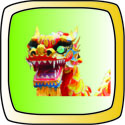 |
The Azure Dragon of SpringIn Ancient Astrology |
The Azure Dragon of the East
Sometimes called the Azure Dragon of the East, the azure, or blue-green dragon was chosen by the earliest Chinese astronomers to represent the planet Jupiter, and positions of the moon against certain stars in the eastern sky. It also represents the Spring season, and wood.
The seven positions or stations of the Azure Dragon are known as "mansions" because they represent groupings or asterisms of stars. These are called Horn, Neck, Root, Room, Heart, Tail and Winnowing Basket.
The Azure Dragon is seen in stars and the patterns made with stars around them. The moon passes through these stars and groupings in seven days. All together, there are twenty-eight such constellations, one for each day of the lunar month. The Azure Dragon represents seven collections of these stars which look like a dragon.
 |
Azure Dragon Star Chart by Steven Renshaw and Saori Ihara
1=Horn, 2=Neck, 3=Root, 4=Chamber, 5=Heart, 6=Tail, 7=Basket |
Azure Dragon Is Sometime Called Green Dragon or Blue Dragon
The color "azure" is really a blue-green color. Sometimes it is called a blue dragon and other times a green dragon. Not surprising since it was named by ancient Chinese Astrologers thousands of years ago. Ancient Arabian and Indian Astrologers adopted the lunar mensions and developed their own interpretations and Portents.
|
|
|
|
|





